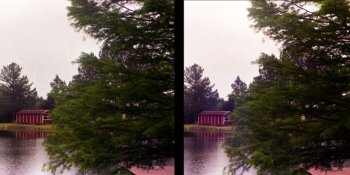So I have a borrowed Manfrotto tripod--one of their pretty basic models, probably for high-end amateurs or maybe videographers, but it's the only stable tripod I have, besides a very small rigid steel one from a telescope. I was looking at it the other day, and since I had just developed an old roll of film from before I sold my stereo camera, I had a thought: two-shot stereo photography. I'd done it once before, sliding my phone camera along a windowsill, but I don't think I slid it far enough to give realistic depth.
So the tripod has a big cork-padded head on it with a long slot for the mounting bolt to slide in, designed so that if you're using the tripod in the most sensible orientation, the bolt slides side-to-side, presumably since 35mm cameras range from having their tripod bushing in the middle to having it all the way at one end.
I mounted my Zenit S (it was what was loaded) and went outside to try some test shots, using this method: I took a shot with the camera mounted so that the bolt was at the right end of the slot, then I wound on and shifted the camera left by about the distance between my eyes (say about two and a half inches, maybe a little less), making very sure to keep the camera parallel to the edge of the tripod head in both shots, and being careful not to jostle the tripod.
It took me some messing around in Irfran, and I had to downgrade the quality to upload it, but here's crops from one of my test pairs, arranged so that you can cross your eyes and see the stereo image. (And yes, I'm aware of the scratches and I'm diagnosing the problem. One thing was that I had a bunch of old film cans piled up in my dark bag.)
Has anyone else here had much xsuccess doing this?
Now, what I really want is a mirror-box type stereo attachment, but most of them are so rare and expensive, and anyways I'd really want one that has threading for a 52mm filter ring (so I could use it with my Canon and Nikon 50mm's and zoom lenses or adapt it down to 48mm for my Minolta and Pentax 50mm's, but until then this method has some cool characteristics. By the way, has anyone here done much with dedicated stereo cameras? Most of them are such unreliable junk, but I messed with a Stereo Realist that seemed nice once.
So the tripod has a big cork-padded head on it with a long slot for the mounting bolt to slide in, designed so that if you're using the tripod in the most sensible orientation, the bolt slides side-to-side, presumably since 35mm cameras range from having their tripod bushing in the middle to having it all the way at one end.
I mounted my Zenit S (it was what was loaded) and went outside to try some test shots, using this method: I took a shot with the camera mounted so that the bolt was at the right end of the slot, then I wound on and shifted the camera left by about the distance between my eyes (say about two and a half inches, maybe a little less), making very sure to keep the camera parallel to the edge of the tripod head in both shots, and being careful not to jostle the tripod.
It took me some messing around in Irfran, and I had to downgrade the quality to upload it, but here's crops from one of my test pairs, arranged so that you can cross your eyes and see the stereo image. (And yes, I'm aware of the scratches and I'm diagnosing the problem. One thing was that I had a bunch of old film cans piled up in my dark bag.)
Has anyone else here had much xsuccess doing this?
Now, what I really want is a mirror-box type stereo attachment, but most of them are so rare and expensive, and anyways I'd really want one that has threading for a 52mm filter ring (so I could use it with my Canon and Nikon 50mm's and zoom lenses or adapt it down to 48mm for my Minolta and Pentax 50mm's, but until then this method has some cool characteristics. By the way, has anyone here done much with dedicated stereo cameras? Most of them are such unreliable junk, but I messed with a Stereo Realist that seemed nice once.











